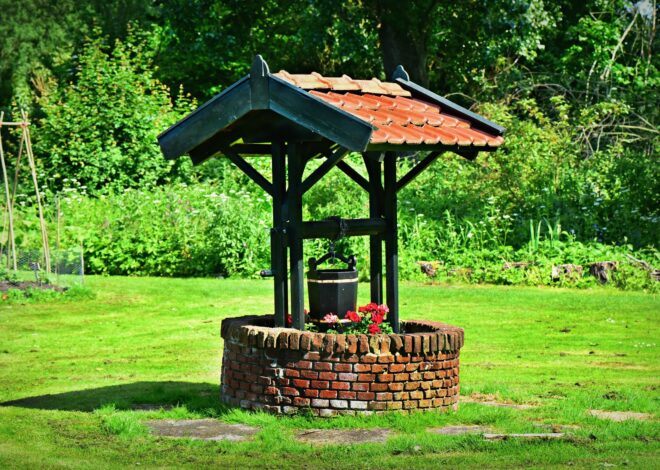
How To Make A Gypsy Well
Welcome to our step-by-step guide on how to make a Gypsy well. Have you ever heard of a Gypsy well? This fascinating tradition, rooted in history and culture, is not just about digging a hole in the ground. It represents a unique way of connecting with nature and utilizing resources sustainably.
Whether you’re looking to create one for practical purposes or simply out of curiosity, understanding how to make a Gypsy well opens up a world filled with rich stories and deep insights into human ingenuity. So grab your tools, roll up your sleeves, and let’s dive into the art of creating this remarkable feature!
History and Cultural Significance of Gypsy Wells
Gypsy wells, often associated with the Romani culture, have a rich history steeped in tradition and resourcefulness. These wells symbolize more than just sources of water; they represent a deep connection to nature and community.
Historically, Gypsy communities relied on these wells during their travels. They served as vital lifelines in areas where access to fresh water was scarce. This practice highlights their adaptive lifestyle and profound understanding of the environment.
The process of creating a Gypsy well is almost ritualistic. It embodies respect for natural resources while fostering social ties among those who gather around it. In many ways, these wells are emblematic of resilience and survival against harsh conditions.
In contemporary society, the significance remains strong. Many still see them as an important cultural heritage that speaks to human ingenuity and communal living. The legacy continues to inspire both admiration and curiosity across diverse cultures today.
Materials Needed for Making a Gypsy Well
To create a Gypsy well, gathering the right materials is essential. Start with sturdy wooden planks or stone bricks for the structure. These will provide stability and durability over time. Next, invest in rope that can withstand heavy weight but remains flexible enough for easy handling.
A strong bucket is also crucial; it should be deep enough to hold water but light enough to lift effortlessly. Don’t forget about a pulley system if you want smooth operation. This will make drawing water easier and more efficient.
Consider some decorative elements like plants or stones around the well’s opening. Not only do they enhance its appearance, but they also blend the well into your landscape beautifully. Each material plays a role in creating an effective and charming Gypsy well.
Step-by-Step Guide on How to Make a Gypsy Well
Step 1: Choosing the Location
Choosing the right location for your gypsy well is crucial. Look for a spot that offers easy access to water underground. This usually means finding areas with dense vegetation or spots where other wells have been dug.
Consider the topography of your land. Avoid places too close to trees, as roots can interfere with digging and may compromise the structure later on. Instead, opt for flat ground if possible; it makes construction simpler.
Think about accessibility when selecting your site. You’ll want room to maneuver while digging and building, plus enough space for transporting materials.
Keep in mind any local regulations regarding water sourcing and well placement. It’s essential to respect these rules while ensuring you’re setting up in a sustainable way that benefits not just you but also those around you. Happy hunting!
Step 2: Digging the Well
Once you’ve chosen the perfect spot, it’s time to get your hands dirty. Digging a Gypsy Well requires determination and a bit of elbow grease.
Start by marking a circular area around your desired center point. Aim for about three feet in diameter to create enough room for digging. Use shovels or spades depending on how deep you need to go, usually around 10-30 feet.
As you dig, keep the walls as straight as possible. This ensures stability once the structure is built. If soil becomes too hard, consider using water to soften it up first.
Be mindful of any roots or rocks that may hinder progress; remove them carefully without damaging tools or yourself. Stay hydrated! Digging can be strenuous work, so take breaks when needed and enjoy the rhythm of nature surrounding you during this process.
Step 3: Building the Structure
Once you’ve dug your well, it’s time to focus on the structure. This is crucial for durability and accessibility.
Start by choosing sturdy materials like wood or stone. Wooden planks are easy to work with, while stones can offer a rustic touch. Whichever you choose, make sure they’re weather-resistant.
Next, create a circular framework around the well opening. This acts as both a safety measure and a support for the bucket system above. You might want to consider adding cross-bracing for extra stability.
Don’t forget about aesthetics! Decorate the outer structure with plants or stones that complement your garden design.
Ensure there’s enough space at the top of the well for pulling up water without obstruction. A solid foundation will enhance longevity and keep your Gypsy Well functional year-round.
Step 4: Adding the Rope and Bucket System
Now it’s time to set up the rope and bucket system, which is essential for retrieving water from your Gypsy well. Start by selecting a durable rope that can withstand heavy loads and resist wear over time.
Attach one end of the rope securely to your bucket. A metal or sturdy plastic bucket works best since it won’t easily break or deform when pulled from depth.
Next, run the other end of the rope through a pulley system if you’ve chosen to incorporate one. This will make lifting much easier and smoother, especially if your well is deep. If not using a pulley, ensure there’s enough clearance around the opening for easy maneuvering.
Test the setup by filling the bucket with water and pulling it up slowly. Make adjustments as needed until everything operates smoothly without any hitches in motion.
Step 5: Testing and Maintenance
Once you’ve built your Gypsy Well, testing it is essential. Fill the bucket with water and pull it up. Ensure the rope moves smoothly through the pulley system without snagging. This will prevent frustration during use.
Check for leaks around the structure as well. A small leak can lead to erosion over time, potentially compromising your well’s integrity.
Regular maintenance is crucial in keeping your Gypsy Well functional. Inspect the bucket and rope periodically for wear and tear. Replace any frayed sections promptly to avoid accidents or malfunctions.
Cleaning out debris from around the well helps maintain its clarity and accessibility. Consider setting a schedule for these maintenance checks, perhaps once every few months.
By staying on top of these tasks, you’ll enjoy a reliable water source that serves you well throughout its lifespan.
Tips and Tricks for Successful Gypsy Well Creation
Creating a Gypsy well can be an exciting endeavor. To enhance your experience, gather the right materials beforehand. A sturdy bucket and rope are essential for effective water retrieval. Location matters greatly. Look for areas with rich soil or lush vegetation; these often indicate groundwater availability.
Pay attention to the surrounding landscape as it may guide you to natural springs. When digging, use a combination of tools like shovels and hands for precision. Take breaks to assess your progress—this helps avoid fatigue while ensuring you’re on track.
Once you’ve reached adequate depth, reinforce the walls using stones or wood planks. This prevents collapse and keeps your well functional over time. Don’t hesitate to consult local experts or resources about traditional methods specific to your area; their insights can prove invaluable in this creative journey.
Alternative Methods for Creating Gypsy Wells
While traditional methods of creating Gypsy wells are popular, there are alternative approaches worth exploring. One method involves using a portable water filtration system. This not only simplifies the process but also ensures clean water.
Another technique is utilizing natural springs or streams nearby. Instead of digging, you can channel water from these sources into your well structure. It’s an eco-friendly option that respects local ecosystems. For those in urban areas, rainwater harvesting systems offer a modern twist on the Gypsy well concept.
By collecting rainwater and storing it for later use, you create a sustainable source without much effort. Consider community gardens where multiple families collaborate to build larger wells together. This fosters community spirit while maximizing resources efficiently. Each method provides unique benefits and reflects diverse needs and environments.
Final Thoughts and Conclusion
Creating a Gypsy well is not just about accessing water; it’s an art form that connects you to traditions rich in history and culture. By understanding its significance, you can appreciate the effort behind each step taken in this process. Your journey begins with the right location, where natural springs or aquifers may reside beneath the earth’s surface.
The preparation phase is crucial. Gather your tools and materials while keeping local regulations on water use in mind. As you progress through digging and constructing, remain patient—good things take time. Utilizing tips from seasoned practitioners can save you frustration down the line.
Remember to check for stability as well; no one wants their hard work compromised by safety issues later on. If traditional methods aren’t feasible for you, exploring alternative techniques could provide viable solutions tailored to your circumstances.
Embarking on this project offers more than access to fresh water; it creates a deeper connection with nature and enriches your appreciation for cultural practices of yesteryear. So gather your materials, embrace creativity, and start crafting your very own Gypsy well today!




This article on How to Make a Gypsy Well is an engaging and practical guide for outdoor enthusiasts and survivalists alike! I appreciate how clearly you’ve broken down the steps for creating a Gypsy Well, making it accessible even for beginners venturing into wilderness survival techniques. The inclusion of safety tips and practical advice on identifying suitable locations for digging is particularly helpful, as it ensures readers can apply this skill effectively and responsibly.
The historical context you provided about Gypsy Wells adds depth to the article, connecting readers with the origins of this survival method. It’s a fascinating blend of practical knowledge and a nod to resourceful traditions that have stood the test of time.
I’m curious—do you have any personal experiences or challenges with using a Gypsy Well in different environments, like sandy terrain or rocky areas? It would be great to hear about variations or adjustments one might need to make depending on the conditions.
Overall, this article is a fantastic resource for those looking to expand their survival skills and connect with nature in a deeper way. Thank you for sharing such insightful and actionable content!
Hi Alan,
Thanks for stopping by today and sharing your thoughts on Gypsy wells. Gypsy wells go back centuries and is a time tested way for gathering your own fresh water. You can apply the techniques mentioned above and give it a try yourself. Remember to think of safety first.
I would suggest that you boil the water collected to kill off any bacteria that may exist. It’s always better to be safe than sorry. When your health may be at risk, always take the proper safety precautions. I am so glad that you enjoyed our guide and got some useful information out of it.
All you have to do is follow the steps above and your Gypsy well should work just fine. I’ve only used this technique in the Appalachian mountains so arid conditions like a dessert are out of my expertise. However, I suspect that it should work as long as you have precipitation.
If you decide to go ahead and build your own Gypsy well. Please come back and share your experience with us. I’d love to know how your Gypsy well turns out. Thanks again for stopping by and if you have any more questions on Gypsy well. Don’t hesitate to ask.
Best wishes,